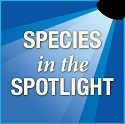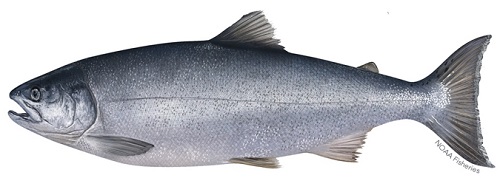 Coho salmon are one of the 28 salmonids federally listed by NOAA on the U.S. west coast. They are known for their anadromous life style, in which breeding and hatching of young take place in rivers and as adults will migrate to the North Pacific, returning after 3 years to spawn and die. Once abundant, they supported native, recreational and commercial fishing.
Coho salmon are one of the 28 salmonids federally listed by NOAA on the U.S. west coast. They are known for their anadromous life style, in which breeding and hatching of young take place in rivers and as adults will migrate to the North Pacific, returning after 3 years to spawn and die. Once abundant, they supported native, recreational and commercial fishing.
Central California Coast coho salmon (Oncorhynchus kisutch) were first listed as threatened in 1996, and subsequently reclassified as an endangered species in 2005. This unique run of coho salmon, at the southern extent of the species’ range, has teetered on the brink of extinction.
All available time series show a continued and significant downward trend, poor adult returns, and an increase in the risk of extinction since 2005. The two exceptions are the Russian River and Scott Creek, where recent increases of adult abundances have been observed due to the operation of conservation hatchery programs.
To address the critical status of this imperiled species, we are marshalling resources and reaching out to vital partners to stabilize their populations and prevent extinction.
Threats
While there is no single factor responsible for central coast coho salmon decline, both human activities and natural events have degraded coho habitats, and it is necessary to address these habitat problems. The impacts of simplified freshwater and estuarine habitats, reduced instream flow, and increases in stream temperatures are more or less obvious. Less obvious are changes in species productivity and diversity. Habitat restoration is helping; however, it may not have the expected immediate effects on central coast coho populations, which may suffer from this lost genetic diversity and possible adaptations to degraded conditions. Restoration work to reduce threats is underway, but additional emergency measures may be needed to protect genetic diversity.

Recovery
State and Federal Agencies, public organizations, non-profit groups and others have formed alliances to save Central California Coast coho salmon across its range. The extinction prevention actions have included habitat restoration and protection, education, research, monitoring, agency initiatives, and two conservation hatchery programs. The two programs include the large Russian River program and tiny hatchery facility on Scott Creek. While differing in size and funding, these programs were initiated in 2001 due to severely depressed coho salmon numbers. Fish are collected from the wild, brought into the hatcheries, genetically tested, and spawned to maximize diversity and prevent inbreeding. In the hatchery, fish are raised to various ages, fed, tagged, and released into the wild. Field crews release the juvenile fish at low densities into the best available habitats. This release strategy allows the fish to imprint on the creek with the goal that they will return to these streams as adults to spawn naturally.
The need for facility improvements and funding for these programs is a constant challenge, and the prolonged and severe drought has made sustaining coho salmon difficult. Nonetheless, these programs have saved coho from extinction. For the Russian River, adults returning to their release streams has increased steadily and naturally-spawned offspring have been observed in 12 of the 23 streams surveyed. For Scott Creek, the number of returning adults and naturally-spawned offspring is the largest observed in over 10 years. Each conservation hatchery program has a remarkable story. A group of dedicated agencies, scientists, non-profit organizations, and other collaborators have rescued these runs of coho salmon from near certain extinction.
Dedicated partners and focused actions are essential to saving Central California Coast coho salmon from extinction.
- The State/NOAA Fisheries led Coastal Monitoring Program is a critical platform to inform status and trends of coho salmon.
- NOAA Fisheries and the California Department of Fish and Wildlife formed a “Priority Action Coho Team” to assemble State and Federal recovery plan priorities and actions to prevent coho salmon extinction.
- The State has collaborated with NOAA Fisheries to improve water management, drought response, freshwater recreational fishing, forestry practices, science and research, and focus restoration dollars (partially funded by the Pacific Coastal Salmon Recovery Fund) on coho salmon.
- Efforts are underway to extend the NOAA Veterans Corp program, which is improving stream conditions and providing veterans with valuable job skills in California, into the central coast coho salmon range by 2016.
- Water agencies have altered flow regimes, conducted restoration and support the conservation hatchery program.
- Counties are restoring streams and revised regulations to discourage wood removal and improve habitats.
- The Nature Conservancy has worked with the State and NOAA Fisheries to develop a comprehensive source of information on populations, habitat conditions, and recovery actions found on their “California Salmon Snapshot” website.
- Non-profits and public organizations are providing critical outreach, training, education, and on-the-ground assistance for restoration.
- Private and public land owners are investing in Safe Harbor agreements, Habitat Conservation Plans, Conservation Banks, habitat restoration, research, and providing outplanting sites for juveniles reared at the two conservation hatcheries.
These actions are working to save Central California Coast coho salmon from extinction and are paving a path forward to recovery. NOAA Fisheries is developing a 5-year plan of action for this species, which will build upon the Central California Coho Salmon Recovery Plan and detail the focused efforts needed over the next 5 years.
—-
About Central California Coast
Coho Salmon
LOCATION
- This evolutionarily significant unit, or ESU, includes naturally spawned coho salmon originating from rivers south of Punta Gorda, California to and including Aptos Creek, as well as such coho salmon originating from tributaries to San Francisco Bay.
STATUS
- By the late 1990s, coho salmon were reduced to only a few remaining places and on the verge of extinction. All available time series show a continued and significant downward trend, poor adult returns, and an increase in the risk of extinction since 2005.
HABITAT
- Coho spend approximately the first half of their life cycle rearing and feeding in streams and small freshwater tributaries. Spawning habitat is small streams with stable gravel substrates. The remainder of the life cycle is spent foraging in estuarine and marine waters of the Pacific Ocean.
- Critical habitat was designated on May 5, 1999 for the Central California Coast and Southern Oregon/ Northern California Coast coho salmon.
Check out these related habitat restoration projects.
A NOAA’s First Habitat Focus Area: Progress in the Russian River (2014)
VIDEO: Russian River
Branciforte dam removal (time lapse video) (2013) (San Lorenzo R., Santa Cruz County, Central Calif. Coast)
NOAA Focuses on Russian River Habitat (2013)
Russian River: Habitat Focus Area (2013)
MORE
- Central CA Coast Coho Salmon Information
- Central CA Coast Coho Salmon Recovery Plan
- Coho Salmon Species Information
- PODCAST: Saving Coho Salmon
- NOAA FishWatch – Coho Salmon
- Coho Salmon Maps & GIS Data
- VIDEO: Juvenile Central CA Coast Coho Salmon (Scott Creek)
- California’s Ten Mile River: Restoration Transformation
What Can You Do?
- Conserve water. Water is a critical part of California’s way of life. The state’s economy, environment, and people need water to flourish. Unfortunately, there is limited water to meet these needs – especially during this historic drought. Californians are acting now to make water conservation a way of life. Please visit saveourwater.com to find out what you can do to make conservation a part of your daily life.
- Learn more about our Species in the Spotlight.
- Learn more about Coho Salmon.
- Read the latest report on Recovering Threatened and Endangered Species.
- Check out what our leader, Eileen Sobeck, has to say about our Species in the Spotlight.
PARTNERSHIP INFORMATION
LINKS
- The Nature Conservancy: CA Salmon Snapshots
- Russian River Coho Water Resources Partnership
- California Dept of Fish and Wildlife – Coho Recovery
- National Park Service — Coho & Steelhead Salmon Monitoring
VIDEOS
- A Fan for the fish and the Martorana Family Winery
- Coho Release into Dry Creek Habitat Restoration Sites
- Russian River Coho Salmon Captive Broodstock Program
- USACE Dry Creek Reach 15 Restoration Project
- Salmon Life Cycle Monitoring
- Wild Coho Salmon in Willow Creek Aug 2013
- Saving Salmon, Saving Us
- Saving Salmon, One Log at a Time
